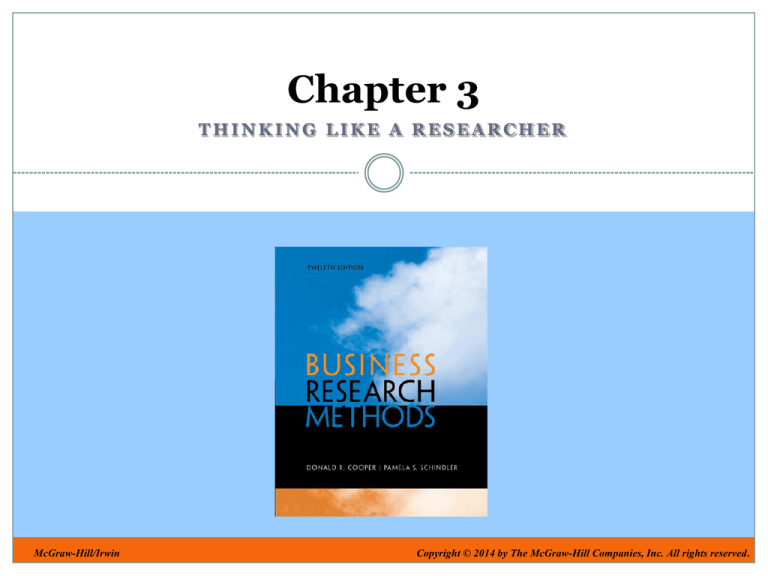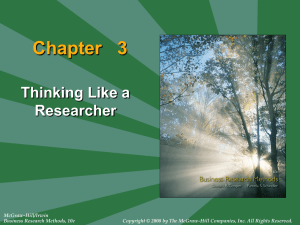
Chapter 3
THINKING LIKE A RESEARCHER
McGraw-Hill/Irwin
Copyright © 2014 by The McGraw-Hill Companies, Inc. All rights reserved.
Learning Objectives
Understand . . .
The terminology used by professional
researchers employing scientific thinking.
What you need to formulate a solid
research hypothesis.
The need for sound reasoning to enhance
research results.
3-2
Research Thought Leaders
“Thought leaders, academics, business authors from
the increasingly merging worlds of psychology,
philosophy, economics, trends, semiotics are powerful
forces, that have the ability to capture the imagination
and attention at the highest level of business.
Research needs to define itself more broadly, embrace
the most exciting thinkers into our fold. We need to
infuse our thinking with that of related fields.”
Edward Appleton,
senior European consumer insights manager,
Avery Dennison
3-3
Language of Research
Concepts
Constructs
Models
Terms used
in research
Theory
Conceptual
schemes
Operational
definitions
Variables
Propositions/
Hypotheses
3-4
Language of Research
Success
of
Research
Clear conceptualization
of concepts
Shared understanding
of concepts
3-5
Job
Redesign
Constructs
and
Concepts
3-6
Operational Definitions
How can we define the variable
“class level of students”?
Freshman
< 30 credit hours
Sophomore
30-50 credit hours
Junior
60-89 credit hours
Senior
> 90 credit hours
3-7
A Variable: Property Being Studied
Act
Event
Variable
Characteristic
Trait
Attribute
3-8
Types of Variables
Dichotomous
Male/Female
Employed/ Unemployed
Discrete
Ethnic background
Educational level
Religious affiliation
Continuous
Income
Temperature
Age
3-9
Independent and Dependent Variable
Synonyms
Independent
Variable (IV)
Predictor
Presumed cause
Stimulus
Predicted from…
Antecedent
Manipulated
Dependent
Variable (DV)
Criterion
Presumed effect
Response
Predicted to….
Consequence
Measured outcome
3-10
Relationships Among Variable Types
3-11
Relationships Among Variable Types
3-12
Relationships Among Variable Types
3-13
Moderating Variables (MV)
The introduction of a four-day week (IV) will lead to
higher productivity (DV), especially among younger
workers (MV)
The switch to commission from a salary compensation
system (IV) will lead to increased sales (DV) per worker,
especially more experienced workers (MV).
The loss of mining jobs (IV) leads to acceptance of
higher-risk behaviors to earn a family-supporting income
(DV) – particularly among those with a limited education
(MV).
3-14
Extraneous Variables (EV)
With new customers (EV-control), a switch to
commission from a salary compensation system (IV)
will lead to increased sales productivity (DV) per
worker, especially among younger workers (MV).
Among residents with less than a high school
education (EV-control), the loss of jobs (IV) leads to
high-risk behaviors (DV), especially due to the
proximity of the firing range (MV).
3-15
Intervening Variables (IVV)
• The switch to a commission compensation
system (IV) will lead to higher sales (DV) by
increasing overall compensation (IVV).
• A promotion campaign (IV) will increase savings
activity (DV), especially when free prizes are
offered (MV), but chiefly among smaller savers
(EV-control). The results come from enhancing
the motivation to save (IVV).
3-16
Propositions and Hypotheses
Brand Manager Jones (case) has a higher-than-
average achievement motivation (variable).
Generalization
Brand managers in Company Z (cases) have a
higher-than-average achievement motivation
(variable).
3-17
Descriptive Hypothesis Formats
Descriptive
Hypothesis
In Detroit, our
potato chip market
share stands at
13.7%.
American cities are
experiencing budget
difficulties.
Research
Question
What is the market
share for our potato
chips in Detroit?
Are American cities
experiencing budget
difficulties?
3-18
Relational Hypotheses Formats
Correlational
Causal
Young women (under
35) purchase fewer units
of our product than
women who are older
than 35.
An increase in family
income leads to an
increase in the
percentage of income
saved.
Loyalty to a grocery
The number of suits sold
varies directly with the
level of the business
cycle.
store increases the
probability of
purchasing that store’s
private brand
products.
3-19
The Role of Hypotheses
Guide the direction of the study
Identify relevant facts
Suggest most appropriate
research design
Provide framework for organizing
resulting conclusions
3-20
Characteristics of
Strong Hypotheses
Adequate
A
Strong
Hypothesis
Testable
Better
than rivals
3-21
Theory within Research
3-22
The Role of Reasoning
3-23
A Model within Research
3-24
The Scientific Method
Direct observation
Clearly defined variables
Clearly defined methods
Empirically testable
Elimination of alternatives
Statistical justification
Self-correcting process
3-25
Researchers
• Encounter problems
• State problems
• Propose hypotheses
• Deduce outcomes
• Formulate rival
hypotheses
• Devise and conduct
empirical tests
• Draw conclusions
3-26
Why is
curiosity
important?
3-27
Sound Reasoning
Types of Discourse
Exposition
Deduction
Argument
Induction
3-28
Deductive Reasoning
Inner-city household
interviewing is especially
difficult and expensive
This survey involves
substantial inner-city
household interviewing
The interviewing in this
survey will be especially
difficult and expensive
3-29
Deductive Reasoning
Apply deductive
reasoning to this
image.
What will happen
next?
3-30
Inductive Reasoning
Why didn’t sales increase during our
promotional event?
Regional retailers did not have sufficient stock
to fill customer requests during the
promotional period
A strike by employees prevented stock from
arriving in time for promotion to be effective
A hurricane closed retail outlets in the region
for 10 days during the promotion
3-31
Why Didn’t Sales Increase?
3-32
Tracy’s Performance
3-33
Key Terms
Argument
Case
Concept
Conceptual scheme
Construct
Deduction
Empiricism
Exposition
Hypothesis
Correlational
Descriptive
Explanatory
Relational
Hypothetical construct
Induction
Model
Operational definition
Proposition
Sound reasoning
Theory
Variable
Control
Confounding (CFV)
Dependent (DV)
Extraneous (EV)
Independent (IV)
Intervening (IVV)
Moderating (MV)
3-34
Chapter 3
ADDITIONAL DISCUSSION OPPORTUNITIES
McGraw-Hill/Irwin
Copyright © 2014 by The McGraw-Hill Companies, Inc. All rights reserved.
PicProfile: Shopping & Mobile Phones
3-36
Snapshot: Politicized Definitions
The National Academies
advises on scientific issues.
Created voluntary guidelines for
embryonic stem cell research.
Comprehensive definition of terms
accepted by every researcher.
Volatile political issue =
no nationwide guidelines
Politicians fill the void with own
definitions to exploit personal agenda.
3-37
Snapshot: Radio Chips vs. Retinal Scans
Prevent cattle-born disease with
database of cattle
Track cattle from birth to slaughter
Theory 1: RFID tag with tracking
data in ear-mounted tag
Theory 2: retinal scan with
tracking data in hand held reader
3-38
Snapshot: Gut Hunches
“People usually
experience true intuition
when they are under
severe time pressure
or in a situation of
information overload or
acute danger, where
conscious analysis of the
situation may be difficult
or impossible.”
3-39
Pull Quote: Research Thought Leaders
“Brand communities play a pivotal role for a
brand connecting with its consumers, and as
one of our Never Ending Friending focus group
respondent notes: “I want brands to be my
friends,” which means that consumers would
like to have common ideas, conversations and
benefits delivered to them on their own terms.”
Judit Nagy
vice president, consumer insights
MySpace/Fox Interactive Media
3-40
PulsePoint: Research Revelations
55
The percent of executives who
admitted that their companies do not
have an official policy for social
networks.
3-41
Formulating a Hypothesis
Wal-Mart recently decided not to share
its unit sales information with IRI, a
large syndicated research distributor.
After studying the data, Wal-Mart didn’t
think it was getting enough value from
competitor information in the syndicate.
What hypothesis might have driven its
research?
3-42
Chapter 3
THINKING LIKE A RESEARCHER
McGraw-Hill/Irwin
Copyright © 2014 by The McGraw-Hill Companies, Inc. All rights reserved.
Photo Attributions
Slide Source
26
27
29
30
37
38
39
Photo by Pegy Greb, USDA-ARS
Tetra Images/Getty Images
©George Hammerstein/Corbis
Erik Isakson/Blend Images/age fotostock
©Brand X Pictures/PumnchStock
Jeff Vanuga, USDA-NRCS
Ingram Publishing
3-44






